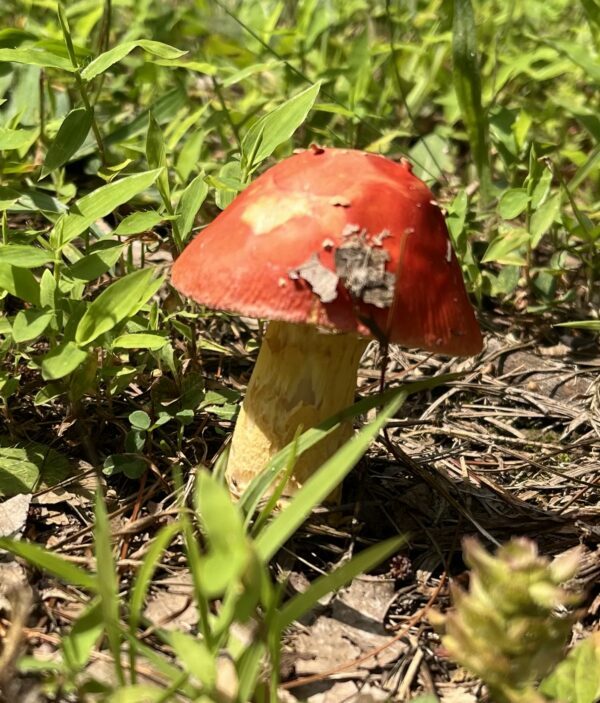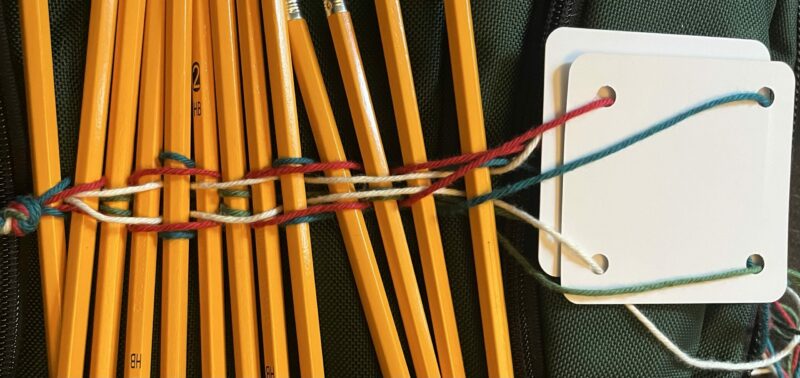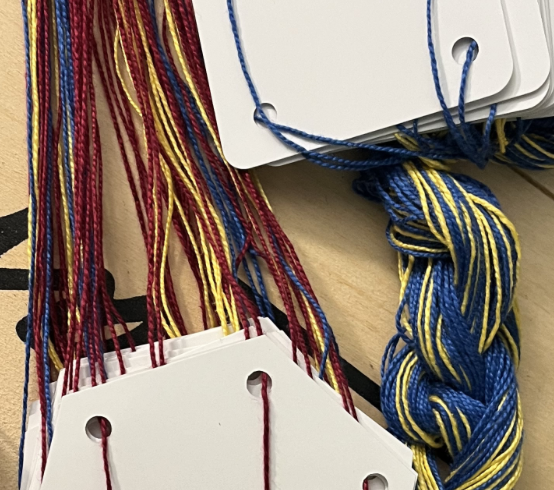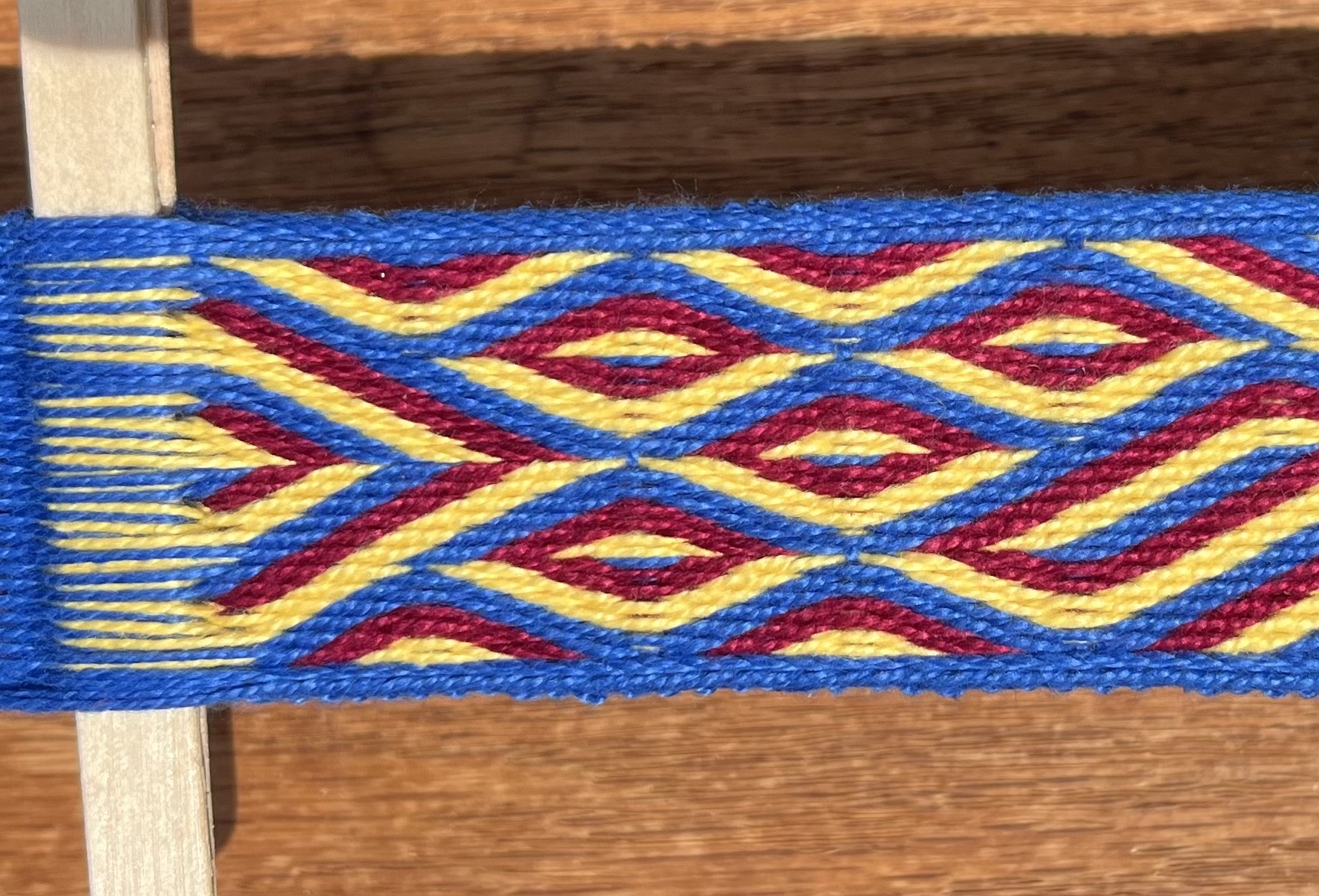Jenny Dean is doing a series of articles on Anglo-Saxon dyeing, with pretty pictures (Part 1, Part 2).
I’ve been doing some modern dyeing, but for a Viking purpose: much more of the insane silk for a larger project. I want to end up with enough for the front of an apron dress. I’m thinking, oh, 300 cards.

Nice bright Viking colors. Those are two-yard skeins, and each is 1,000 yards. Except for the blue – that’s 1,500. This silk is demon-possessed, I’m sure of it. I’ve made horrible messes with previous dyeing experiments. This time, I will win. There are ties every 3 inches, I was ridiculously careful with the dyepot and the rinsing, and I used those nifty giant twist ties.
Shortly after I read a post by Leigh on using large rings made of coathanger wire covered in taigon tubing to hold dye skeins (I think it was Leigh, but I can’t find the original post right now – apologies!) I found this pack of silicone-covered wire twist ties in my local grocery.
Edit: Right! Michael pointed out that I learned about the rings from Sandra Rude, an entirely different weaving blogger.


They’re boilable, bakable, and completely sealed. I had a little bit of trouble with the silk getting caught in the knot, but with larger threads (or ones not demon-possessed), that would not be much of a problem. They worked great as handles. The silicone doesn’t transmit heat well at all, so I can handle them directly from the dyebath. That alone was worth the moderate expense of purchasing these (about $15 for the set – via an online supplier I know nothing about). If you do a lot of dyeing of skeins, especially fine threads, these are worth considering.






7 responses to “Dyeing”
ooh, what gorgeous colors!
I learned about dye rings from Sandra Rude:
https://sandrarude.blogspot.com/2008/08/handling-skeins-in-dyepot.html
I haven’t gotten around to making any yet, but yours look GREAT!
I am curious how those four colors are called “Viking” colors.
Eilidh, they are loose approximations of natural dye colors available in northern Europe, done on reeled silk. The first Jenny Dean link has a photo of nice bright naturally-dyed red, yellow, and blue on wool. Green would be from overdyeing blue with yellow (or the other way around; I’m at work and can’t remember which way it goes).
Strong colors take more dyestuff, and so are more expensive. That fits with the use of silk, and with the purpose for which this is intended – what would be high-end and ostentatious decoration on clothing.
The Viking bit, though, was more intended to describe the proposed use: tablet weaving using techniques known in pre-1000 Scandinavia, and to be applied to a Viking dress. The dyes were chosen to complement that goal, but weren’t an end in themselves (being modern synthetic dyes and all).
Is that what you were asking, or was there something specific you were interested in?
Ah, that makes sense, thank you. My curiousity was piqued, since at first I was thinking “how are crayola-rich colors Viking colors?” but I see what you mean now. And I cannot wait to see your tablet-weaving with these silks–that’s going to be gorgeous!
When I look at Jenny Dean’s “Anglo-Saxon Dye Experiments – Part 2” entry, the wide collection of oranges, corals, yellows, and browns are the range of colors that remind me of “Look! Natural Dyes!” more than say, the “crayola basics” that we think of for yellow, blue, green, and red. In fact, I want to do a several-year study of “so what do we mean by ‘red’ anyways?” since I rarely get anything close to a modern idea of “red” from natural dyestuffs. But I’m the queen of all things pink or orange at the moment! *giggle*
Great colors, great explanation. Thank you!
That’s why I referenced specifically the first link, with the “crayon” primaries. And that’s on wool – you can get brighter/more saturated colors on silk. :) I agree, it’s much easier and cheaper to get muted tones, but for high-status items the brights and jeweltones are perfectly reasonable, I think.
I’m not good enough with natural dyes to get them (reliably – you should see some of my screwups!), but I’ve seen examples. The intensity isn’t the problem in using these for a Viking weaving piece, but rather the tone. I _didn’t_ look at natural samples, and then select modern dyes that would replicate the correct tone (eg orangey reds vs purply reds), but just used what was on hand. The later would be an interesting project – what combinations of
primaries produces the right tonal range for woad, madder, weld, kermes? For modern dying, I use two sets of primaries, one warm and one cool, so I should theoretically be able to replicate most anything.
Thanks for your thoughts!
Sounds exciting! I look forward to all your photos and commentary! Keep up the great work! :)